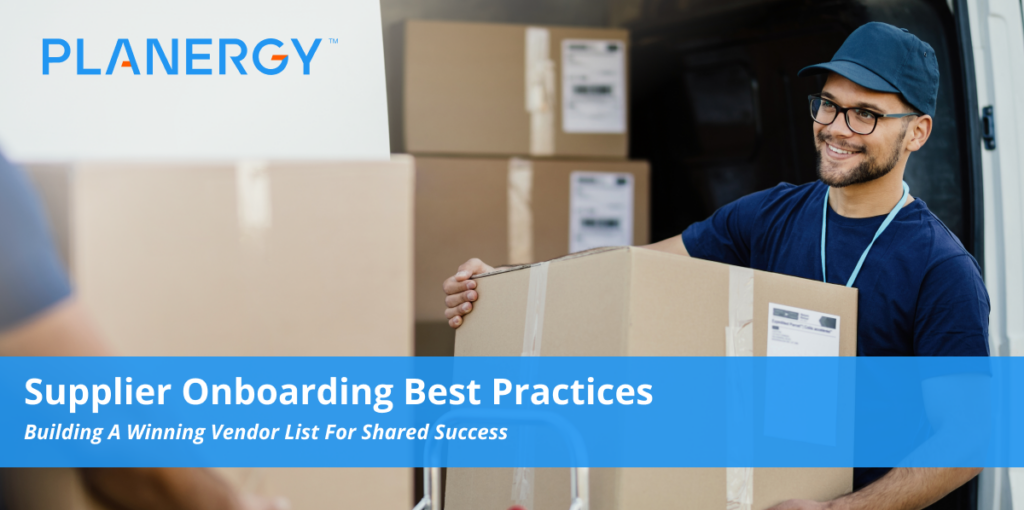Building lasting success for your business relies on a number of factors, and one of the most important of these is an effective and strategic supply chain. But identifying and connecting with the best suppliers for your company’s unique needs can be challenging.
To be effective, supplier onboarding—the process of bringing new suppliers into your supply chain—requires a savvy combination of risk assessment, due diligence, and business relationship management.
Navigating this process can be difficult without the proper tools and business processes.
However, by learning and implementing best practices, the onboarding process can be streamlined and optimized to ensure every vendor in your supply chain is your partner in shared success.
What is Supplier Onboarding?
Also known as vendor onboarding, the vendor onboarding process, or supplier relationship management (SRM), the supplier onboarding process gives businesses and other organizations a way to gather the information they need to evaluate, approve, and add new suppliers to their systems, as well as buy goods and services from, and make payments to, those same vendors.
Any vendor that provides your company with goods or services in exchange for payment is a supplier. This applies to both direct and indirect spend.
Because it involves bringing an external party into your organization’s closed system and making them “part of the team,” supplier onboarding is in many ways similar to employee onboarding.
Just as your human resources department must carefully evaluate and educate potential staff before they can add them to the payroll, your procurement team must qualify vendors based on reputation and performance, educate them about your company’s business practices, internal processes, regulatory essentials, and expectations for the business relationship you hope to build with them.
Evaluating prospective suppliers in this way helps minimize miscommunication and unmet expectations while maximizing the potential for shared success as the new partnership moves forward.
Before you can bring new vendors onboard, you’ll need to know what you’re looking for in terms of performance, reliability, pricing, reputation, and compliance.
Building an Effective Supplier Onboarding Process
Bringing together several different but interrelated processes, supplier onboarding is designed to move prospective suppliers through each of the stages between initial supplier data collection and final contract.
For most organizations, developing (and, in time, streamlining) your supplier onboarding process can be achieved in six easy steps:
1. Establish Evaluation and Approval Parameters.
Before you can bring new vendors onboard, you’ll need to know what you’re looking for in terms of performance, reliability, pricing, reputation, and compliance.
Create onboarding checklists and ensure you have an efficient method for collecting and verifying both contact information and detailed supplier information (e.g., past performance, compliance histories, legal or reputational troubles) you need to determine whether a given supplier is a yes or no.
2. Define Requirements and Expectations.
Nobody likes playing a game without knowing the rules. Like most people, vendors appreciate clear and comprehensive communication.
By communicating your expectations, business policies, and other requirements with vendors during supplier onboarding, you can not only save time that might otherwise be wasted in clearing up misunderstandings, but streamline the overall evaluation process by quickly identifying which vendors have potential as strategic suppliers and which are a poor fit for your team.
3. Save Time and Effort with Vendor Portals.
Create a vendor portal (also called a supplier portal). This dedicated data collection system provides prospective suppliers with self-service access to registration for evaluation.
Doing so not only helps familiarize new vendors with your system, but frees your team from low-value data entry tasks and slash the average time required when onboarding a new supplier.
You can incorporate the parameters, requirements, and expectations developed in steps 1 and 2 within the portal, streamlining the data entry process and improving both the speed and accuracy of your data collection and evaluation processes.
4. Create and Incorporate a Process for Identifying and Prioritizing Strategic Supplier Relationships.
Some vendors have a larger impact on your company’s performance and bottom line than others. They may represent a larger amount of spend, or provide strategic value through superior performance, access to a specific resource at exceptional pricing, etc.
If a vendor is identified as a potential strategic partner during the initial onboarding process, a separate, dedicated process for bringing strategic suppliers into the fold gives your team (and any additional stakeholders required to approve strategic suppliers) additional options with regard to evaluation and approval without disrupting or delaying the overall onboarding process.
5. Center Your Processes on Clarity and Communication.
So many lost opportunities, damaged relationships, and expensive delays can be laid at the feet of a single issue plaguing the modern workplace: poor communication.
When everyone is on the same page, it’s much easier to ensure the onboarding process, from risk assessment to data management, is as swift, accurate, and complete as possible.
6. Invest in Technology
Even the best, most efficient processes will never be at their best if they’re being done on paper with human hands.
Automation and artificial intelligence—two of the key technologies in digital transformation, and cornerstones of continuous improvement in business process management—power up your processes, remove human error, and free your staff from repetitive, easily-automated drudgery to focus on high-value tasks that require a human touch.
The right cloud-based procurement solution can take many of the headaches out of the supplier onboarding process by moving all your data to a secure and shared space in the cloud, with real-time, complete, and transparent access for all stakeholders.
Integrations with your existing purchasing and accounting systems make it easy to incorporate new suppliers and ensure your buyers are getting the best payment terms from the moment your supplier list is updated.
In addition, more advanced tasks are supported by powerful analysis tools that reveal hidden opportunities to add new suppliers (or pursue new shared initiatives with existing ones), eliminate underperforming vendors, and implement innovation into your production line.
The Supplier Onboarding Process
Once you’ve established your criteria, decided how best to handle potential strategic suppliers, and laid out your overall goals for building strong and strategic supplier relationships, you can build your actual supplier onboarding process.
The process itself centers on your vendor onboarding checklist, which provides a thumbnail sketch you can follow as you flesh out your supplier onboarding process to make sure you’ve included all the essentials.
- Initial Vendor Evaluation
- Collect and organize supplier information.
- Supplier name and contact information (including titles and roles for key contacts)
- Vendor licenses and required documentation
- Review vendor’s service record and reputation.
- Review and evaluate credit history.
- Perform compliance assessment (legal, industry, governmental, etc.)
- Obtain vendor sign-off on your code of conduct and ethics.
- Collect and organize supplier information.
- Vendor Qualification and Approval
- Clarify expectations and requirements regarding:
- Lead times
- Pricing
- Terms and conditions
- Workflow and business process compliance
- Delivery
- Training (including internal systems training to engage with your procurement and accounting systems for data transmission, invoicing, etc.)
- Data Management
- Review all submitted data for completeness and accuracy.
- Ensure all stakeholders, including accounting, purchasing, and logistics staff, have real-time access to relevant information as required.
- Review suppliers for potential role as strategic suppliers.
- If a supplier meets the requirements, move the supplier to the next phase of review.
- Add standard suppliers to the system, update all relevant systems (including procurement and accounting) to connect vendor data with associated goods and services, as well as invoicing and tracking of vendor management key performance indicators (KPIs).
- Monitor and Review
- Perform regularly scheduled reviews of vendor performance and compliance.
- Monitor vendor data to identify potential opportunities for new market development, process improvement, or product innovation based on access to new materials and markets.
- Streamline your supply chain as necessary to reduce the number of suppliers required while ensuring all contingencies remain covered.
- Clarify expectations and requirements regarding:
Key Benefits of Effective Supplier Onboarding
Developing a robust and well-managed supplier onboarding process helps your team create a supplier relationship management program that’s effective and efficient.
Open, honest, and clear communication, paired with explicit expectations and complete data transparency, gives every supplier relationship the firm foundation it needs to grow into a strategic partnership focused on mutual success.
In addition, your organization will see related benefits, including:
- Streamlined processes and greater efficiency.
- Enhanced risk mitigation (supported by data management and transparency)
- A healthy and positive industry reputation as a buyer.
- A sleek, well-tuned supply chain with minimal bloat.
- Reduced human error, invoice fraud, and maverick spend.
- Enhanced industry, legal, and governmental compliance.
- A healthier bottom line supported by optimal return on investment (ROI).
Supplier Onboarding Best Practices
No two companies are alike, and chances are, your supplier onboarding process may not look much like your competition’s—especially if you automate and prioritize continuous improvement.
However, every organization can benefit from keeping a few best practices in mind when developing and deploying a successful supplier onboarding process.
- Enlist the aid of the C-Suite. Top-down buy-in from the beginning of the development process will make it much easier to bring the rest of the company on board with your supplier onboarding process.
- Don’t overlook due diligence. Consistent and effective supplier risk management is built on knowing what needs to be done, when it needs to be done, and how it needs to be done.
- Prioritize data security. Invest in data management technology that secures all your data, including supplier information, payment data, and customer data, with the latest and most reliable options possible.
- Automate, automate, and automate. Greater efficiency, fewer errors, and tighter control over your supply chain management process flow will be your reward.
- Stay flexible. The only certainty is that things will change. Focus on continuous improvement, rather than hard lines of performance, to ensure your system is ready for tomorrow’s supplier relationship challenges as well as today’s.
Build a Winning Team of Suppliers
No matter what goods or services your company offers, it’s the business relationships you establish and nurture that will have the most profound effect on your success.
Investing the time, energy, and resources to build and automate your supplier onboarding process will yield big dividends in the form of stronger supplier relationships, reduced risk, and more frequent opportunities for smart and strategic sourcing.




